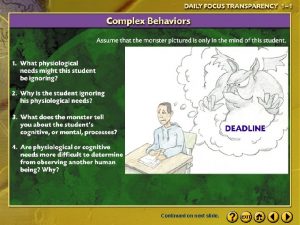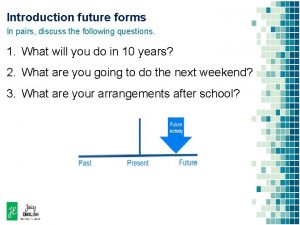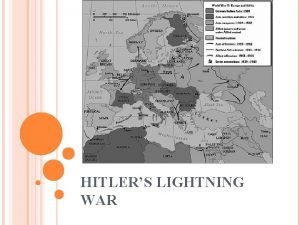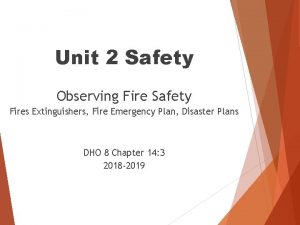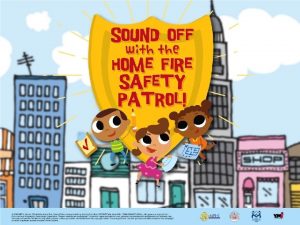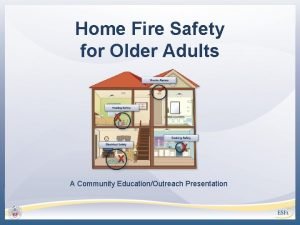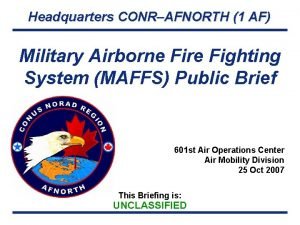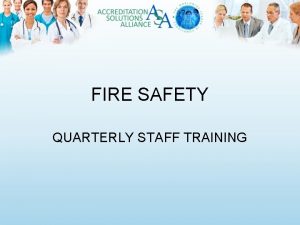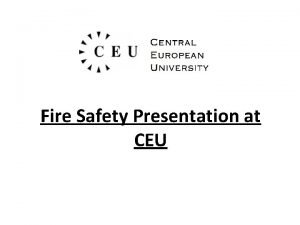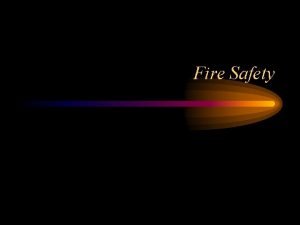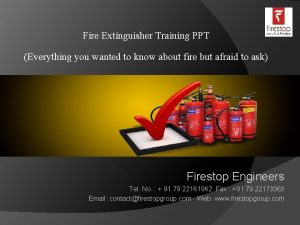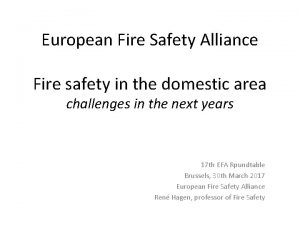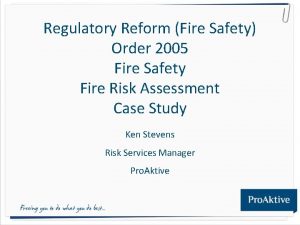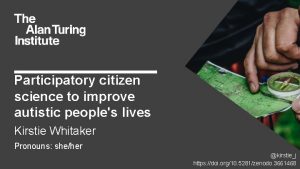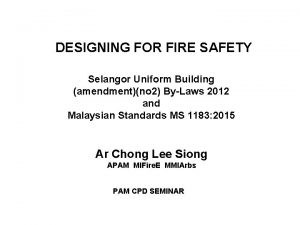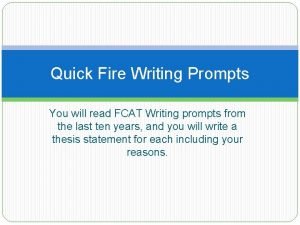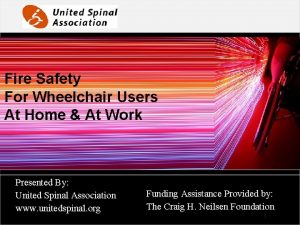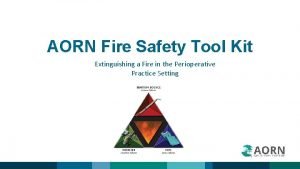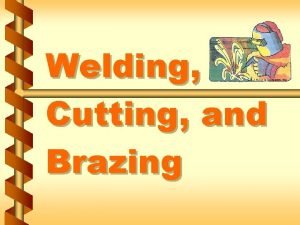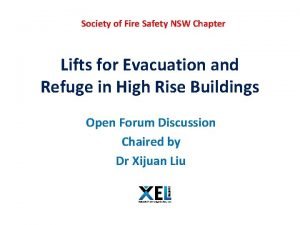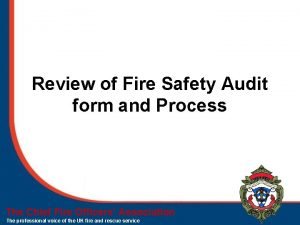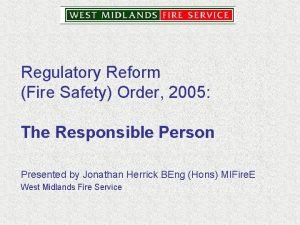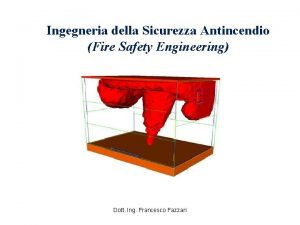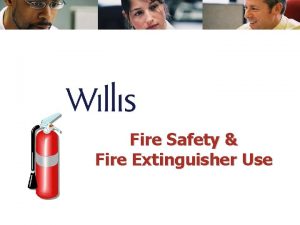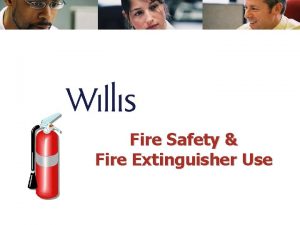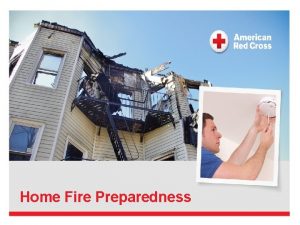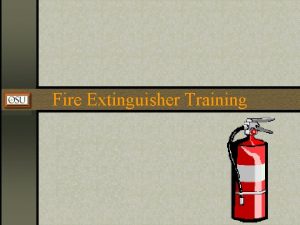Fire Safety at Work Next Slide Why do





































- Slides: 37

Fire Safety at Work Next Slide

Why do we do this training Because many people are unnecessarily injured by fire at work each year Because the law specifically requires larger employers to train its staff in Fire Safety Because Fire Risk Assessments flagged a need to train staff in Fire Safety Next Slide

What is Fire? The rapid oxidation of a fuel evolving heat, particulates, gases and non-ionizing radiation Next Slide

Fire Triangle For fires to start and then carry on burning 3 things are required Fuel Heat Oxygen Next Slide

Fire Prevention Hazard Reduction Reduce/Remove Fuel Reduce/Remove Heat source Reduce/Remove Oxygen Next Slide

Examples of Initial Sources of Heat Smoking Electrical equipment Heaters Contractors tools and equipment Arson Next Slide

Examples of Fuels Paper & Boxes etc. Plastics Flammable Liquids Carpets & Furniture Waste materials Flammable Gases Next Slide

Classes of Fire A Fire is classified According to source of Fuel A - Free burning materials, paper, wood, plastics etc. B - Flammable liquids, petrol, meths, solvents etc. C - Flammable gases, methane, hydrogen etc. D - Metals, potassium, sodium, magnesium etc. Electricity can be involved in any class of fire Next Slide

Fire Procedure Fire Alarm Leave the building immediately Use the nearest exit Walk quickly but don’t run closing doors behind you Do not delay your exit to collect your belongings Attend the Fire Assembly Point and report to the Fire Marshal Do not return until told to do so Next Slide

Fire Procedure Finding a Fire Sound the fire alarm Fight the fire if you are competent and you consider it safe to do so Evacuate as per normal fire procedure Inform the Fire Marshal Next Slide

Fighting a Fire Do not fight the fire if : It is bigger than a waste paper bin One extinguisher is not enough Smoke is affecting your breathing You cannot see the way out Gas cylinders or chemicals are involved Your efforts are not reducing the size of the fire Next Slide

Fire Extinguishers - Water Red body Suitable for use on Class A Fires, wood and paper etc. Not suitable for combustible liquids, cooking fats etc. Not safe to use on fires involving electricity Extinguishes by cooling Next Slide

Fire Extinguishers - Foam Cream body (Old type) or Red Body with Cream label Suitable for Class A and B Fires. Not suitable for use on fires involving electricity Extinguishes by cooling and sealing the surface of a burning liquid Next Slide

Fire Extinguishers - Powder Blue body (Old type) or Red body with blue label. Best on Class A, B, C & E Works by chemically interfering with the combustion reaction Next Slide

Fire Extinguishers Carbon Dioxide Black body (Old type) or red body with black label (New type) Best on Class B Safe to use on fires involving electricity Extinguishes by reducing oxygen levels and cooling Next Slide

Fire Blanket Any colour body or label but they are usually red or white For use on any type of fire but best on small contained class B fires and people on fire. Extinguishes by cutting off the oxygen supply Next Slide

Fire Safety Test 1. Fuel, Oxygen and Heat are needed for a fire to exist True False

Fire Safety Test 1. Fuel, Oxygen and Heat are needed for a fire to exist 2. It is safe to use a water type extinguisher on class B fires CLICK EITHER TRUE OR FALSE IF CORRECT YOU WILL GO TO THE NEXT QUESTION. IF WRONG YOU WILL SEE THE ANSWER True False

Fire Safety Test 1. Fuel, Oxygen and Heat are needed for a fire to exist 2. It is safe to use a water type extinguisher on class B fires 3. It is safe to return to your place of work when the alarm stops CLICK EITHER TRUE OR FALSE IF CORRECT YOU WILL GO TO THE NEXT QUESTION. IF WRONG YOU WILL SEE THE ANSWER True False

Fire Safety Test 1. Fuel, Oxygen and Heat are needed for a fire to exist 2. It is safe to use a water type extinguisher on class B fires 3. It is safe to return to your place of work when the alarm stops 4. Powder extinguishers can be used on all types of fires CLICK EITHER TRUE OR FALSE IF CORRECT YOU WILL GO TO THE NEXT QUESTION. IF WRONG YOU WILL SEE THE ANSWER True False

Fire Safety Test 1. Fuel, Oxygen and Heat are needed for a fire to exist 2. It is safe to use a water type extinguisher on class B fires 3. It is safe to return to your place of work when the alarm stops 4. Powder extinguishers can be used on all types of fires 5. The fire triangle indicates the distance between assembly points CLICK EITHER TRUE OR FALSE IF CORRECT YOU WILL GO TO THE NEXT QUESTION. IF WRONG YOU WILL SEE THE ANSWER True False

Fire Safety Test 1. Fuel, Oxygen and Heat are needed for a fire to exist 2. It is safe to use a water type extinguisher on class B fires 3. It is safe to return to your place of work when the alarm stops 4. Powder extinguishers can be used on all types of fires 5. The fire triangle indicates the distance between assembly points 6. To extinguish a fire remove either the Heat source the fuel or the oxygen True False

Fire Safety Test 1. Fuel, Oxygen and Heat are needed for a fire to exist 2. It is safe to use a water type extinguisher on class B fires 3. It is safe to return to your place of work when the alarm stops 4. Powder extinguishers can be used on all types of fires 5. The fire triangle indicates the distance between assembly points 6. To extinguish a fire remove either the Heat source the fuel or the oxygen 7. Do not fight fire if its bigger than a waste paper bin True False

Fire Safety Test 1. Fuel, Oxygen and Heat are needed for a fire to exist 2. It is safe to use a water type extinguisher on class B fires 3. It is safe to return to your place of work when the alarm stops 4. Powder extinguishers can be used on all types of fires 5. The fire triangle indicates the distance between assembly points 6. To extinguish a fire remove either the Heat source the fuel or the oxygen 7. Do not fight fire if its bigger than a waste paper bin 8. Co 2 extinguishers are red bodied with a black label True False

Fire Safety Test 1. Fuel, Oxygen and Heat are needed for a fire to exist 2. It is safe to use a water type extinguisher on class B fires 3. It is safe to return to your place of work when the alarm stops 4. Powder extinguishers can be used on all types of fires 5. The fire triangle indicates the distance between assembly points 6. To extinguish a fire remove either the Heat source the fuel or the oxygen 7. Do not fight fire if its bigger than a waste paper bin 8. Co 2 extinguishers are red bodied with a black label 9. Foam extinguishers can be used on fires involving electricity True False

Fire Safety Test 1. Fuel, Oxygen and Heat are needed for a fire to exist 2. It is safe to use a water type extinguisher on class B fires 3. It is safe to return to your place of work when the alarm stops 4. Powder extinguishers can be used on all types of fires 5. The fire triangle indicates the distance between assembly points 6. To extinguish a fire remove either the Heat source the fuel or the oxygen 7. Do not fight fire if its bigger than a waste paper bin 8. Co 2 extinguishers are red bodied with a black label 9. Foam extinguishers can be used on fires involving electricity 10. Fire blankets can be used on all types of fires True False

Fire Triangle For fires to start and then carry on burning 3 things are required Fuel Heat Oxygen Return To Questions

Fire Extinguishers - Water Red body Suitable for use on Class A Fires, wood and paper etc. Not suitable for combustible liquids, cooking fats etc. Not safe to use on fires involving electricity Extinguishes by cooling Return To Questions

Fire Procedure Fire Alarm Leave the building immediately Use the nearest exit Walk quickly but don’t run closing doors behind you Do not delay your exit to collect your belongings Attend the Fire Assembly Point and report to the Fire Marshal Do not return until told to do so Return To Questions

Fire Extinguishers - Powder Blue body (Old type) or Red body with blue label. Best on Class A, B, C & E fires Works by chemically interfering with the combustion reaction Return To Questions

Fire Triangle For fires to start and then carry on burning 3 things are required Fuel Heat Oxygen Return To Question

Fire Prevention Hazard Reduction Reduce/Remove Fuel Reduce/Remove Heat source Reduce/Remove Oxygen Return To Questions

Fighting a Fire Do not fight the fire if : It is bigger than a waste paper bin One extinguisher is not enough Smoke is affecting your breathing You cannot see the way out Gas cylinders or chemicals are involved Your efforts are not reducing the size of the fire Return To Questions

Fire Extinguishers Carbon Dioxide Black body (Old type) or red body with black label (New type) Best on Class B fires Safe to use on fires involving electricity Extinguishes by reducing oxygen levels and cooling Return To Questions

Fire Extinguishers - Foam Cream body (Old type) or Red Body with Cream label Suitable for Class A and B Fires. Not suitable for use on fires involving electricity Extinguishes by cooling and sealing the surface of a burning liquid Return To Test

Fire Blanket Any colour body or label but they are usually red or white For use on any type of fire but best on small contained class B fires and people on fire. Extinguishes by asphyxiating Return To Test

This is to certify that of WWM CRC has completed Fire Safety Training in the Workplace 2016/2017
 X.next = x.next.next
X.next = x.next.next Fire hose reel signage standards
Fire hose reel signage standards Heel toe polka dance steps
Heel toe polka dance steps Andreas carlsson bye bye bye
Andreas carlsson bye bye bye Continued on next slide
Continued on next slide Dont ask why why why
Dont ask why why why Reichstag fire who was the fire starter
Reichstag fire who was the fire starter Damper interface panel
Damper interface panel Ire fire fire rwi
Ire fire fire rwi Race fire
Race fire Slide divide slide
Slide divide slide What do you think work in pairs and discuss the questions
What do you think work in pairs and discuss the questions Hitlers lightning war
Hitlers lightning war Chapter 14:3 observing fire saftey
Chapter 14:3 observing fire saftey Home fire safety patrol
Home fire safety patrol European fire safety community
European fire safety community Military fire safety
Military fire safety Race fire safety
Race fire safety Fire safety presentation
Fire safety presentation Fire safety objectives
Fire safety objectives Basic fire fighting training ppt
Basic fire fighting training ppt European fire safety community
European fire safety community Aorn fire risk assessment
Aorn fire risk assessment Regulatory reform fire safety order 2005
Regulatory reform fire safety order 2005 Paul nelis fire safety
Paul nelis fire safety Culinary crossword 2.1 fire safety
Culinary crossword 2.1 fire safety Pressurized hydrant system malaysia
Pressurized hydrant system malaysia Fire safety writing prompts
Fire safety writing prompts Fire safety for wheelchair users
Fire safety for wheelchair users Chapter 14 promotion of safety
Chapter 14 promotion of safety Aorn fire safety
Aorn fire safety Welding safety program
Welding safety program Mfb fire warden training
Mfb fire warden training Fire safety audit form
Fire safety audit form Regulatory reform fire safety order 2005 summary
Regulatory reform fire safety order 2005 summary Ingegneria sicurezza antincendio
Ingegneria sicurezza antincendio Nfcc fire safety in specialised housing
Nfcc fire safety in specialised housing Brainpop jr fire safety
Brainpop jr fire safety




